New generation of players and biomechanics research push serve speeds to record-breaking heights.
Wimbledon’s Historic Moment
In a stunning display at Wimbledon 2025, French tennis player Giovanni Mpetshi Perricard served a 153 mph rocket, setting a new record for the tournament’s fastest serve. At just 21 years old, the world No. 36 has become the face of a rising generation of players who treat their serve not just as a starting shot, but as a decisive weapon. Though Perricard modestly claims his technique “came naturally,” experts say there’s far more behind his record-breaking power.
Decoding the Serve: Science Behind the Speed
Sports scientist Mark Kovacs, known for his work with elite players like John Isner, has broken down the tennis serve into eight distinct stages: stance, toss, loading, coiling, acceleration, contact, deceleration and finish. The real key, says Kovacs, lies in mastering what’s known as the kinetic chain — how force travels through the body from the ground to the racket.
Kovacs points to two especially critical stages: loading (stage three) and the acceleration-contact-deceleration sequence (stages five to seven). In particular, a quick drive from the back hip and a “live arm” — the ability to move rapidly and efficiently through the motion — are top indicators of serve speed. While some players appear to have raw talent, data now shows these elements are measurable and trainable.
The Role of Height and Equipment
Height has become an increasingly common trait among powerful servers. Albano Olivetti, a 6-foot-8 French player known for one of the biggest serves in the game, hit a 160 mph serve in 2012 — the second-fastest ever recorded, though not officially recognized by the ATP. Olivetti credits his height but also emphasizes technique and training.
Kovacs agrees, noting that players over 6’6″ gain a mechanical advantage by hitting down on the ball at contact. This not only allows for more speed but also better control. However, both Kovacs and Olivetti stress that height is only part of the equation. Olivetti, who now focuses on doubles, explains that equipment like racket tension plays a significant role. The right setup can boost power but may compromise other parts of a player’s game, such as baseline control.
No Ceiling in Sight
Despite already incredible numbers, both Kovacs and Olivetti believe serve speeds will continue to climb. According to Kovacs, current players, including world No. 1 Jannik Sinner, still have untapped serving potential. He estimates some could gain up to 10 mph with improved biomechanics.
Environmental factors also matter. Kovacs points to the unusually hot and dry weather at Wimbledon this year, which made the air thinner and the ball faster — possibly adding up to 5 mph to serve speeds.
With more research, better training tools, and growing attention to serve mechanics, tennis could soon see even more milestones fall. As Olivetti puts it, chasing speed records is not just a side goal — it’s a passion shared by the game’s biggest hitters.



